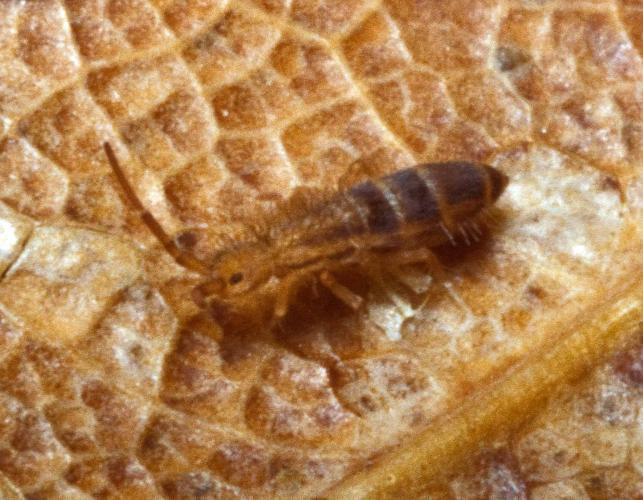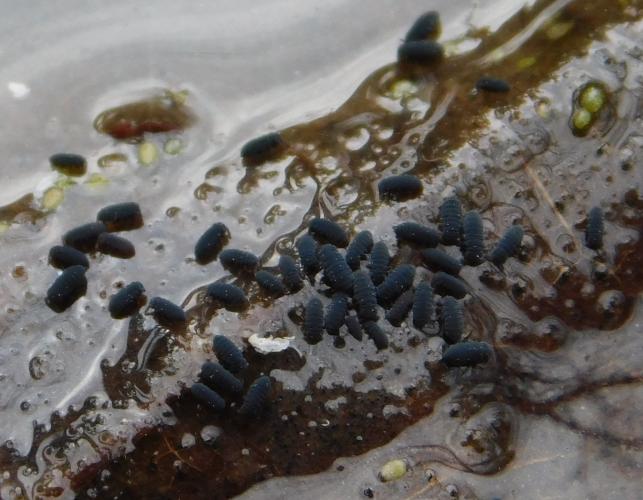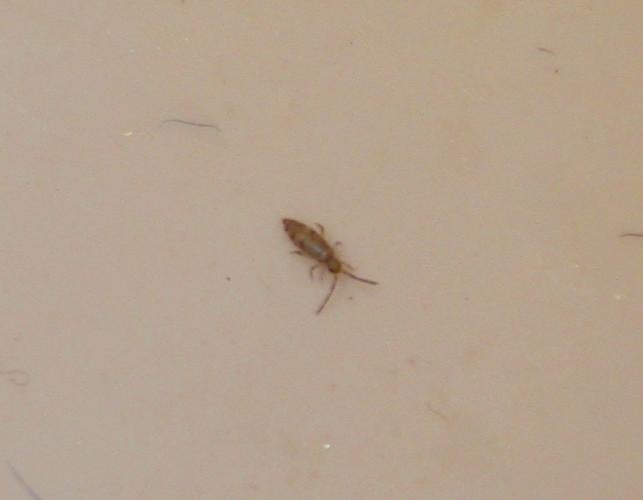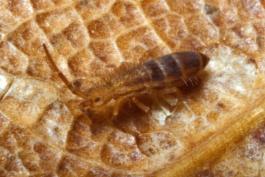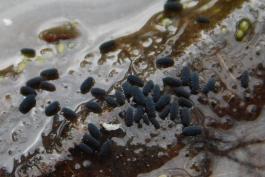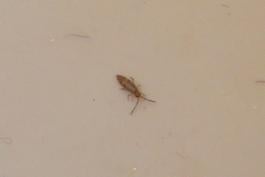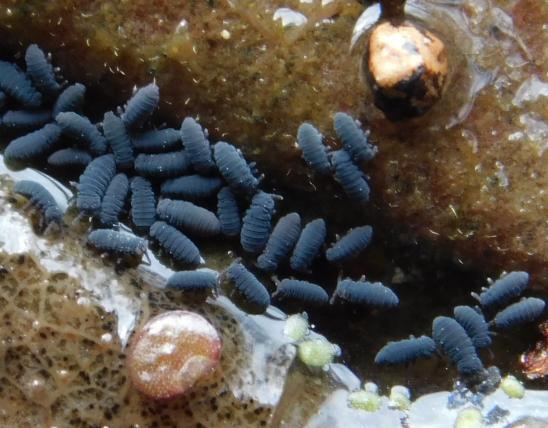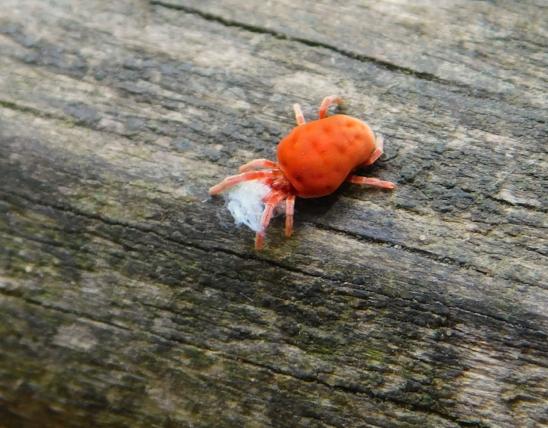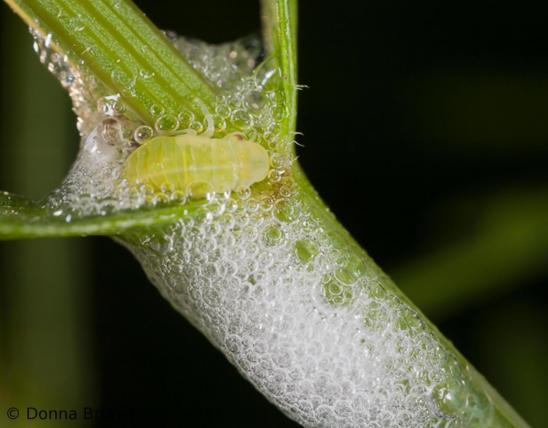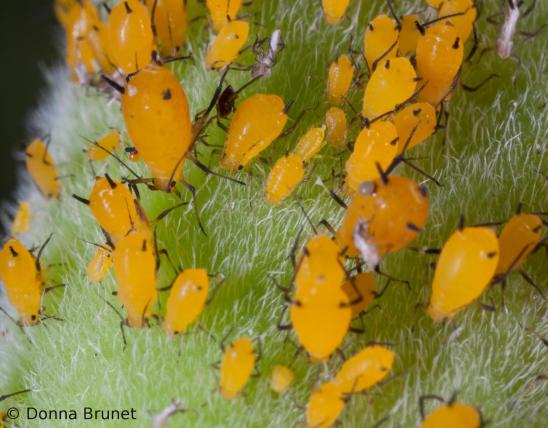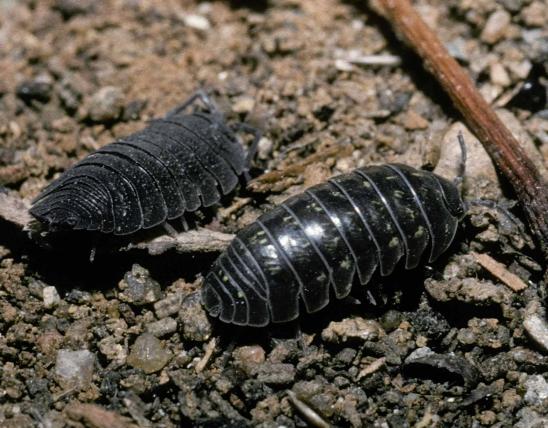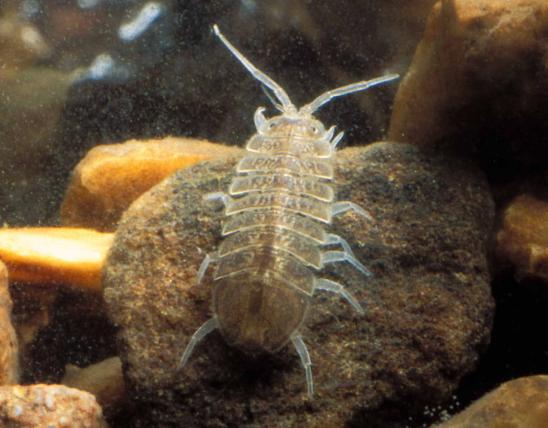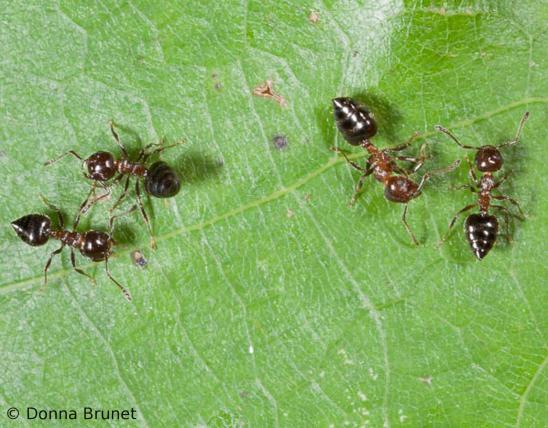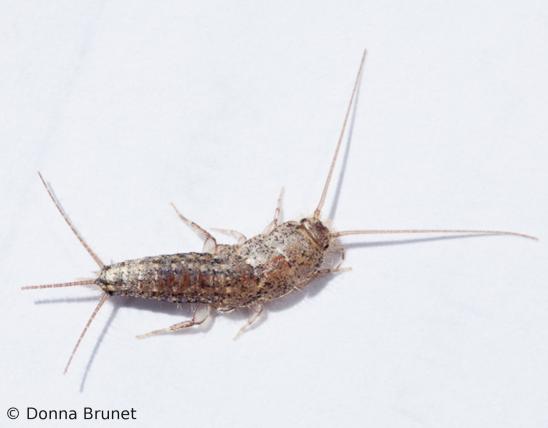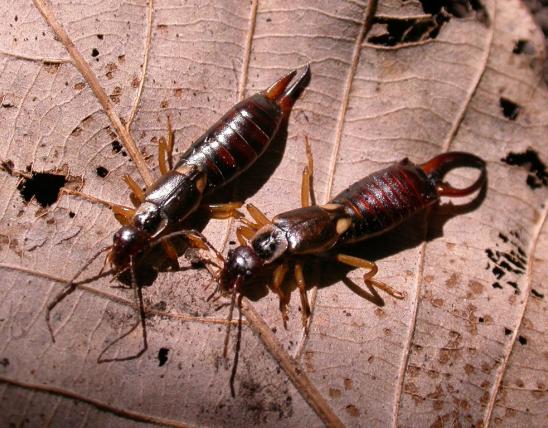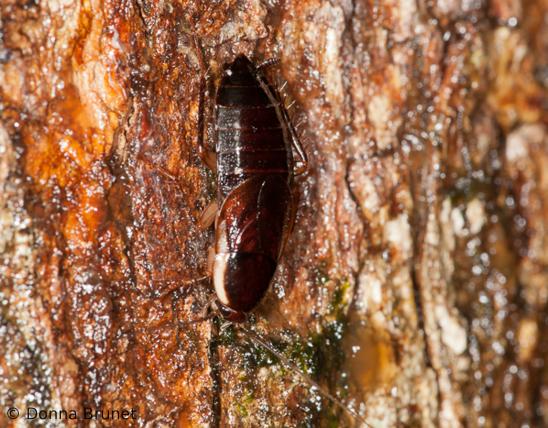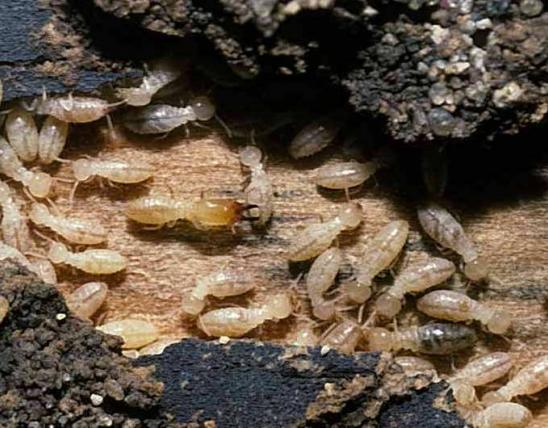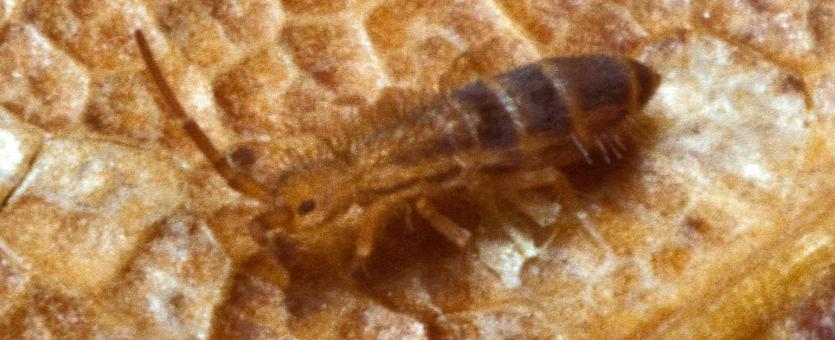
Springtails, like insects, have six legs, but these tiny, oval or elongated creatures have several traits that have convinced biologists they have a separate lineage.
- They lack wings. Although some insects also lack wings, they apparently evolved from ancestral forms that possessed wings.
- Many springtails can spring (jump) using a forked tail-like structure (furcula) attached to abdomen segments 4 or 5. The furcula is usually held folded under the abdomen, and a latch (tenaculum) holds it in place. When the tenaculum is released, the furcula straightens suddenly, flipping the animal upward.
- Springtails have a small tube (collophore) extending downward on abdomen segment 1. Two sacs can be everted from this tube. These sacs have different uses, depending on the type of springtail.
- Some springtails are covered with minute scales, something like the tiny scales on butterfly wings. The coating of scales can make the springtail look iridescent in certain kinds of light.
- Springtails have 6 or fewer segments in the abdomen. Antennae are short, with only 4–6 segments.
- Eyes: Springtails appear to have two eyes, but these two dark spots are actually clusters of up to 8 single eyes (they are not technically compound eyes). Generally, 6 of these sense light/dark, and the other 2 detect polarized light. Additional eyes are located on the face between and below the antennae — this looks like a vaguely darker spot, and the eyes here, positioned below the surface of the animal, have no exterior (lenslike or gogglelike) features. Variations occur; for example, cave and soil-dwelling springtails typically lack eyes.
Types of Springtails
Springtails have been classified in different ways over the years. Today, biologists count four orders of springtails in North America, comprising about 25 families. The three main orders are:
1. Water springtails and their relatives (order Poduromorpha, with about 8 families in North America) have oval, plump bodies and always have short legs and antennae. They are often gray or black and lack scales; the antennae have 4 segments. The body surface often looks velvety or granular.
- The most famous springtails are Hypogastrura nivicola and H. harveyi, both called snow fleas because thousands of them can form sizeable patches on the surface of snow. They sometimes accumulate in foot tracks and other indentations in the snow surface, making the low areas appear black. Their bodies create a kind of antifreeze, allowing them to be active in freezing temperatures.
- The water springtail (Podura aquatica) is commonly seen floating on the surface of ponds and other quiet-water habitats, collecting on banks and objects protruding from the water. Adults are bluish gray with reddish appendages. The two forks of the furcula are very long. Often, the empty, white, shedded skins float on the water nearby. Juveniles are orange.
2. Elongate-bodied springtails (order Entomobryomorpha, with about 7 families in North America) are very slim and may have long or short legs and antennae. Viewed from above, the abdominal segments are easy to distinguish. Also called slender springtails, they are usually smooth-bodied, often with detachable scales that make them look iridescent.
- Some of the largest springtails, reaching nearly ¼ inch in length, are in this group, in the genera Pogonognathellus and Tomocerus.
- Members of genus Heteromurus are some of many springtails that are covered in shiny, iridescent scales.
- Members of genus Willowsia, such as W. nigromaculata, are often found in homes, where they live in places with cavelike (moist, damp) conditions: houseplant containers, near sink drains, or in damp basements. They have translucent, iridescent scales, making them look metallic.
3. Globular springtails (order Symphypleona, with about 8 families in North America) have round, nearly ball-shaped bodies. The antennae are longer than the head. Viewed from above, it’s difficult to see the different segments of the abdomen. The two dark eye clusters are usually easy to see. They look a bit like tiny spiders, but only have 6 legs. Many species are tan or yellowish, and many are mottled or striped.
- One example is the water springtail (Sminthurides aquaticus), which is pale yellow with a bluish cast. From a distance, they look like tiny white specks that jump onto the surface of a quiet pond from the bank. The tiny males connect head-to-head with the larger females by grasping their antennae bases. This species might not be native to North America, and instead be native to Eurasia.
- Another globular springtail is the garden springtail (Bourletiella hortensis), which is very common and can live in drier habitats than most other springtails. They have a smooth grayish-brown abdomen and a rusty head. In very large numbers, they can be garden pests.
Length: less than 6 mm (less than ¼ inch). Globular springtails are usually 1–3 mm (not less than 0.7 millimeter). (A millimeter is about equal to the width of a dime.)
Statewide. Different species have different habitats, so therefore they may have different regional distributions within the state.
Habitat and Conservation
The many species of springtails all have their own particular habitats, but one thing they all require is a wet or damp environment; with only a few exceptions, they cannot tolerate dry locations. Most live in the soil, in leaf litter, under loose bark, in moss, and under rocks and fallen logs. Some live in caves, and some live in the tunnels of ants or termites.
Semiaquatic springtails, such as the water springtail, live on the surface of ponds and other slow-moving water. Snow fleas, usually noticed when they swarm on the surface of snow, usually spend most of their time in or on the ground or under loose tree bark.
On sea coasts, some springtail species are adapted for life in intertidal zones such as beaches, tidal pools, and in estuaries. In polar regions, other springtails are adapted for life on glaciers.
Food
Springtails eat decaying organic materials, especially decomposing plants, as well as fungal foods such as molds and mildews. Some species eat decomposing animals, dung, bacteria, or pollen, and some are predatory. The antennae tips are chemical-sensitive (they can smell and taste), and springtails use them to determine whether something is edible or not.
Status
Six species of springtails on listed as Missouri Species of Conservation Concern. All are cave-dwelling species. Generally speaking, these species have small numbers and/or small ranges or limited distributions, making them vulnerable to extirpation from our state.
Taxonomy: For a long time, springtails were considered to be insects, and classified as an order within class Insecta. And why not? They have six legs, and they look a lot like insects, which also have six legs. But springtails have several traits that have convinced biologists they have a separate lineage and belong in their own class, Collembola. To get a sense of perspective, consider that some other arthropod classes include Arachnida (the arachnids, including spiders, mites, and scorpions), Malacostraca (a crustacean order including crabs, crayfish, shrimp, and pillbugs), and Insecta (the insects, including dragonflies, grasshoppers, bugs, flies, fleas, beetles, and bees).
Life Cycle
Springtails hatch from eggs and undergo a number of immature stages, shedding their skin as they grow. Each stage looks more or less like the others, except that juvenile springtails are smaller and usually lighter colored than adults. Some species have only 4 molts, while others may have more than 50. Males deposit spermatophores (tiny containers of sperm) on a substrate or into the female’s genital opening.
Some species of springtails — usually ones that live well below the soil surface — reproduce via parthenogenesis. In these species, females beget offspring that are genetically identical to themselves, without the presence or participation of males. There is less genetic diversity in populations of these organisms, but they typically have high reproductive rates.
Human Connections
Who cares about tiny non-insects that you can barely see? — Anyone who wants nature to work! Springtails are decomposers that, along with fungi and bacteria, break down the mountains of dead leaves, sticks, trees, and other organic materials that fall to the ground every year, and turn it all into beautiful, rich, healthy soil.
The word furcula, used for the two-pronged springing appendage of springtails, is Latin for “little fork.” Furcula is also the official term for the fused clavicles (collar bones) in birds — also known as a wishbone.
Springtails, when they occur in homes, are not harmful in any way. At worst, they can be a nuisance simply by existing. Some species may live in and near water drains and potted plants. To get rid of them, find ways to dehumidify your home, since they need a fairly moist, damp environment to survive. Generally, springtails don’t survive long in houses, because homes are rarely damp continuously.
Springtails in genus Folsomia are used in laboratories to estimate soil pollution levels.
Ecosystem Connections
Springtails perform a huge service ecologically by decomposing dead vegetation and other organic materials, converting it into fertile soil.
Springtails are eaten by a variety of small predators, such small flies, bugs, beetles, pseudoscorpions, small or immature spiders, larval fish, and more.
Fungi can ride on the outer skin of soil-dwelling springtails to new places. In this way, beneficial mycorrhizal fungi can reach tree roots that benefit from the fungi’s presence.
Springtails eat many fungi that can harm plants, helping to ward off fungal diseases of plants.
Springtails’ ability to detect polarized light might be an adaptation that helps them navigate, since it would help them know which direction sunbeams are streaming and reflecting off water. For aquatic springtails such as Podura aquatica, this can help them move toward their preferred environment. Researchers have found that water springtails indeed move toward horizontally polarized light. Several aquatic insects apparently have this ability, too.
The detachable scales that cover many springtails make them slippery — an attacking predator may end up only capturing a clump of scales as the springtail vaults away. A springtail regrows new scales when it molts.
Many springtail species are found globally, and it’s not hard to imagine how they could be transported around the world via shipping and material floating on ocean currents. Some species are so tiny they can ride on the wind like dust motes. They have been captured 9,000 feet high in the air.
